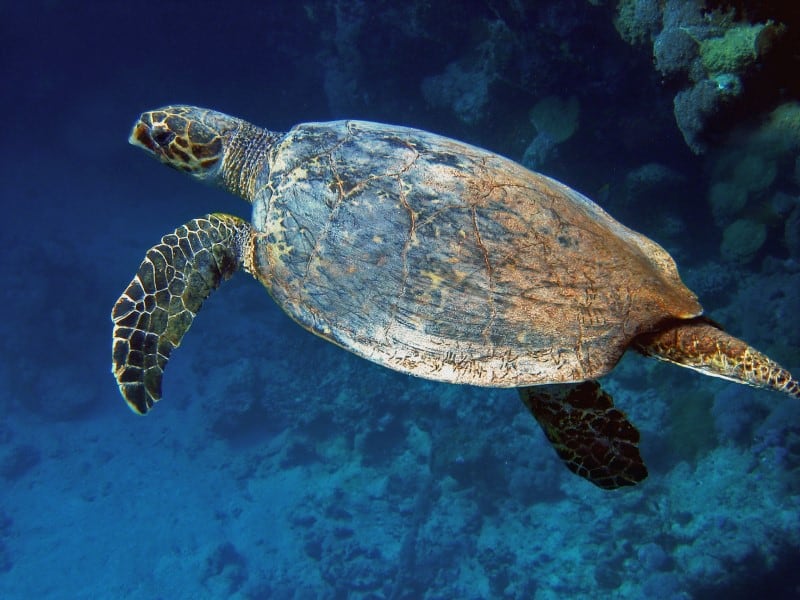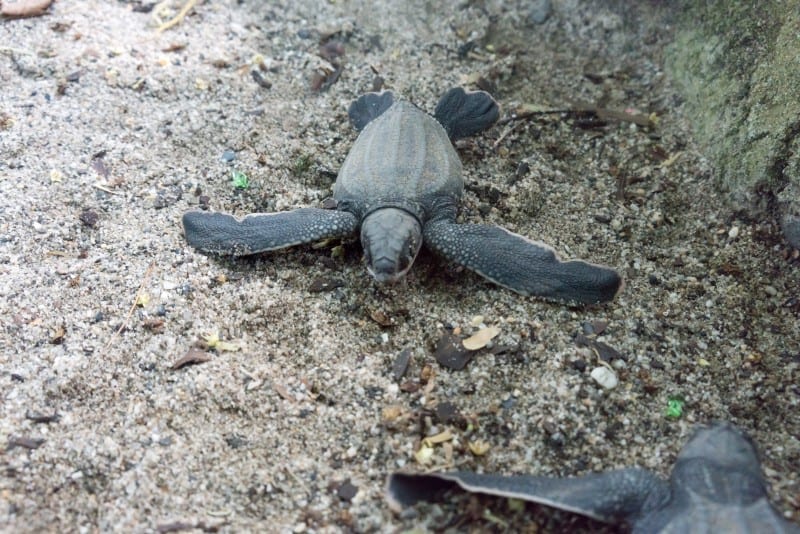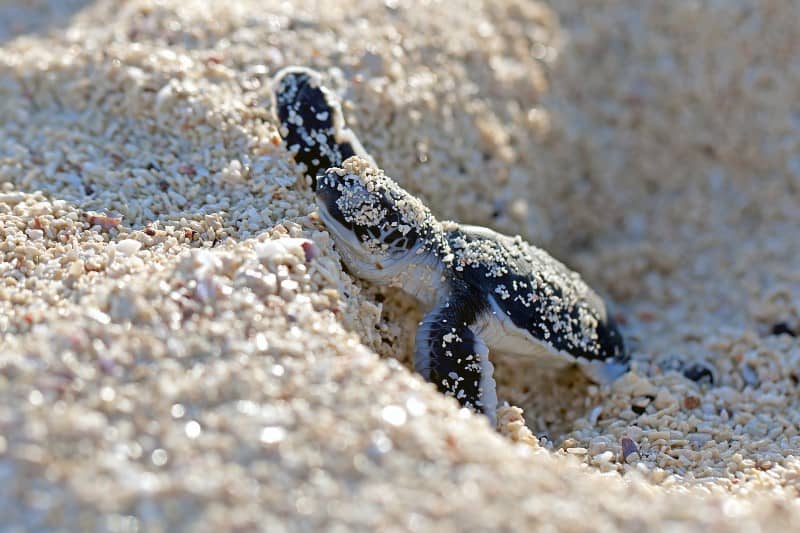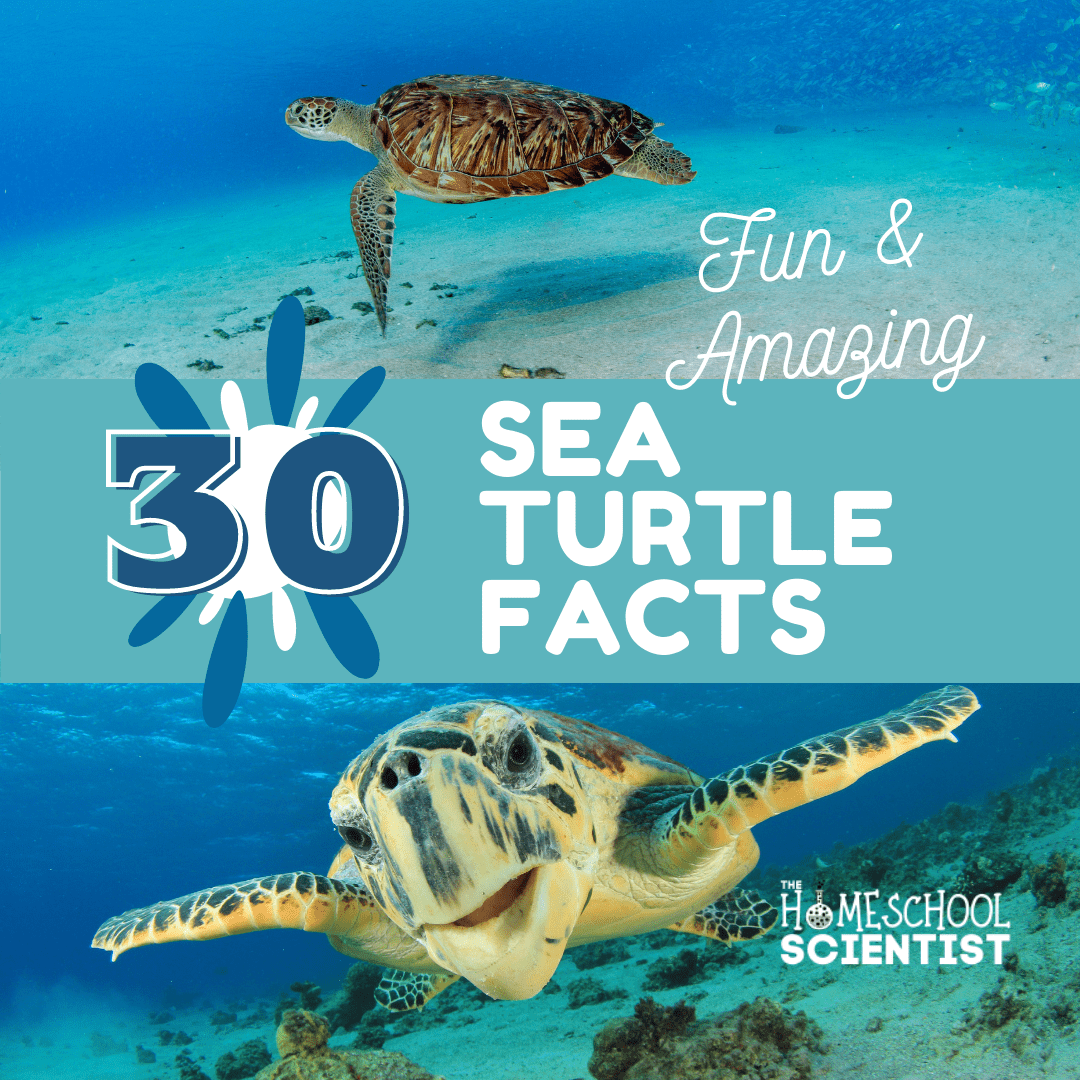Why Are Sea Turtles Endangered & What Can We Do About It?
Nearly every species of sea turtles are endangered, with three sea turtle species classified as critically endangered. At this writing, the Kemp’s ridley sea turtle is the most endangered.
So, why are sea turtles endangered?
The cause of their endangered status ranges from pollution, climate issues, and habitat destruction to fishing, poaching, and slaughter for their meat, eggs, and shells.
Interruptions to the nesting cycle of a sea turtle also is contributing to sea turtles being classified as endangered and critically endangered. Many sea turtle organizations work hard to protect the nests with corrals they construct around a nesting area to keep the public out.
Request the Sea Turtle Printable
Use the box below to request our UPDATED sea turtle printable resources. Your name will be added to the email list of The Homeschool Scientist. You will immediately receive the free sea turtle resources to use with your children or classroom.
Here are things you can do to help protect endangered sea turtles while they are nesting on the beach:
- Fill in any holes you make in the sand. If you like to bury your feet in the sand while sitting on the beach or build sand castles and moats, please fill all the holes back in.
- Clean up your trash!
- If you see a sea turtle on the beach, stay away and don’t touch the turtles. It’s very exciting to see them, but observe from a far distance.
- If you are out driving on the beach, slow down during nesting season. 10 miles per hour or less is a good speed to provide ample time to react and stop should you encounter a sea turtle going to or coming out of the water.
- Do not use bright lights at sunset or after through the night.
Another big way you can help sea turtles is to take your plastic trash with you when you leave the beach or, better still, limit the use of plastic bottles, straws, etc. Rescue organizations do treat turtles who have ingested plastics.
Sea turtles face many natural predators, pollution, and other environmental factors, these small actions are what we can do to help endangered sea turtles.
But while this may seem daunting, there are many amazing conservation efforts that we can all support and even be a part of to help sea turtles survive and thrive.
As we raise awareness about why sea turtles are endangered, it’s important to understand more about their physical characteristics, habitat, and behaviors.
What are the Different Types of Sea Turtles?
There are seven recognized species of sea turtles in the world. All of these species of sea turtles are endangered. These are:
- Loggerhead sea turtle (Caretta caretta): Hard-shelled. On average, weigh 230 pounds and measure 3 feet from beak to tail.
- Green sea turtle (Chelonia mydas): Hard-shelled. On average weigh 300 pounds and measure 3 to 4 feet from beak to tail.
- Leatherback sea turtle (Dermochelys coriacea): Soft-shelled. It can weigh up to 2,000 pounds and measure 6.5 feet from beak to tail.
- Hawksbill sea turtle (Eretmochelys imbricata): Hard-shelled. On average, weigh 100-150 pounds and measure 2-3 feet from beak to tail.
- Kemp’s ridley sea turtle (Lepidochelys kempii): Hard-shelled. Typically weigh less than 100 pounds and measure 2 feet from beak to tail.
- Olive ridley sea turtle (Lepidochelys olivacea): Hard-shelled. Weighing 80-110 pounds and measuring up to 2.5 feet.
- Flatback sea turtle (Natador depressa): Hard-shelled. Weighing up to 190 pounds and measuring between 3 to 3.5 feet.
Don’t forget to download the free worksheets that accompany this post. See the request form at the end of this post.
Read 35 fun facts about sea turtles by clicking here.
Where do Sea Turtles Live?
Sea turtles are found in nearly every ocean worldwide, save for deep within the Arctic and parts of the Southern Ocean closest to Antarctica. However, some species have been found to migrate through the Arctic circle.
Overall, sea turtles have an extensive range of habitats and places to call home. The oldest and largest of sea turtles, the leatherback, also have the most extensive range of nesting and feeding grounds that can have up to a 10,000-mile span between them (For reference, the distance from New York City directly to the South Pole is 9,031.68-miles, that’s no sweat for a leatherback!)
Leatherback sea turtles have the broadest range of all species found from as far north as the Arctic Circle to as far south as the tip of New Zealand.
Followed by leatherbacks are loggerhead sea turtles, which are abundant throughout the world, especially in North America and the Mediterranean Sea.
At the very end of the range spectrum are the flatback sea turtles, whose range is restricted to the tropical waters of the Pacific Ocean around Australia and Indonesia.
Behavior and Diet of Sea Turtles
The study of sea turtle behavior has been hard due to the solitary habits of sea turtles in the open ocean; as fast swimmers and adept divers, it can be hard to track sea turtles once they have left the shore. Most sea turtles can dive up to 1,000ft below sea level, but leatherbacks can quickly dive up to 3,000- even 4,000ft! Even the most well-trained scuba diver can swim down to 60ft but must be extremely careful when returning to the surface.
Female sea turtles are the only members to return to land once hatched. Males opt to stay in the water unless they must return to land.
Sea turtles have an average lifespan of 50 years but can live well beyond that. Some sea turtles reach reproductive maturity as young as seven years old, while others are not mature until they are well in their 30s. Once they have reached maturity, the mating season for sea turtles can range from early spring to early fall.
Where Do Sea Turtles Lay Eggs?
When females are ready to lay their eggs, they often return to the same beach where they hatched.
The ideal location for a sea turtle’s nest is well above the high tide line or even in the dunes. This protects the next from the waves and from roots of any vegetation, should the location be near a forested area.
If the nest is built in the heavier vegetation, there is a risk of being invaded by feral hogs or raccoons.
If the nest is built below the high tide line, the nest has a higher chance of being washed away. Plus, the eggs are permeable, so water can penetrate the shells and drown the developing turtle embryo.
When it is turtle season, local lighting regulations are enforced because artificial light can cause the hatchlings to become disoriented and not find their way to the ocean.
Loggerheads see better in the blue/green spectrum. Orange lights are turtle-friendly, white lights are not. Problems finding their way back to the ocean is one reason why sea turtles are endangered.
Once on shore, they will scout out the best possible location, often creating many “false nests” until she finally finds the ideal spot. There, she will begin to dig with her flippers; once deep enough, she will twist her body to create a larger space until finally, she has created an adequate nest.
Depending on the species, she will spend the next several hours laying her eggs, which can be as many as 50-200 eggs within a clutch. After laying her eggs, she will cover them in the sand and return to the ocean.
It is important that the beaches where they make their nests remain free from bright lights at night. Sea turtles have excellent vision and use light and color to hunt, stay aware and hidden from predators, and to navigate.
Eggs typically take two months to incubate and hatch. The temperature of the sand surrounding the eggs will influence both the speed of incubation and the sex of the hatchling. The hotter the environment, the faster the hatchling will mature, and the more likely it will be female. The cooler the environment, the slower the growth, and the more likely it will be male. This is called temperature-dependent sex determination, which is quite different from the chromosomal basis in humans.
Once the eggs have matured, the hatchlings will erupt from the sand, typically between the middle of the night and early in the morning. This begins the sea turtle’s journey all over again. This trek from the warm nest to the roaring ocean waves can be quite dangerous for hatchlings as poachers, seagulls, and other predators can easily pick away at the hatchlings. That is why many conservationists have begun programs to find nests, monitor them, and provide protection on the day of hatching.
What Do Sea Turtles Eat?
The diets of sea turtles are incredibly diverse. Some species, such as green sea turtles opt for an herbivorous diet, surviving off seaweed, algae, and other marine plants. Many species are omnivorous and will consume any number of marine plants and use their hard beaks to crack the hard outer shells of crabs, whelks, and oysters and eat fish, shrimp, and even coral.
Loggerheads are the only known carnivores, however, their hatchlings are omnivorous.
Two outliers are the leatherbacks who are considered gelatinivores, meaning they subsist mostly from gelatin-like prey such as jellyfish and sea squirts.
The other are the hawksbill turtles, which are considered spongivores because they consist mostly of sponges for their diet.
What Can Be Done to Help Sea Turtles that are Endangered?
As is with most endangered creatures, the reasoning behind the sea turtles’ endangered staus multifaceted and complicated. Many of the reasons can be linked directly to human activity, from entanglement in the nets of fisheries, boat strikes, pollution from the excess of plastics in the oceans, poaching, and the destruction of their natural nesting habitats by land development severe weather patterns caused by climate change.
Another reason why sea turtles are endangered is that they can get caught up in trawl nets that are used to catch shrimp and other small marine animals. The turtles get caught in the nets and can be without air for 30 minutes or more, which endangers their lives. Turtle excluders are devices that have been developed to help prevent sea turtles from getting entangled in the nets.
While some people aim to harm sea turtles for monetary gain, there are many wonderful groups of people working in science and conservation who work tirelessly to protect sea turtles that are endangered and injured.
Sadly, many of these efforts are understaffed and underfunded and are always in need of volunteers and supporters throughout the world.
Many institutions aim towards helping sea turtles focus on the rehabilitation of injured turtles found throughout the world and developing breeding programs to protect the known nesting beaches of females. To study and understand sea turtle migration and behaviors better, scientists will often safely capture turtles, secure a transmitter device to their shell, and then use satellite technology to track the turtle on its journey throughout the world.
Below is a brief look inside a sea turtle rescue center.
Here are some of the sea turtles that were patients when we visited the Georgia Sea Turtle Center on Jekyll Island, Georgia. Several were there due to exposure to extreme cold and others were at the rescue center due to boat strikes. If you look closely at the pages, you can see the details of their rescue, including where they were found and how they were transported to the rescue center.
There are several issues sea face in colder climates that help us understand why are sea turtles endangered:
- Cold-stunning happens when water temperatures drop quickly, and the sea turtles are stunned by the cold waters
- Trauma to the skin on their flippers
- Their immune system becomes compromised
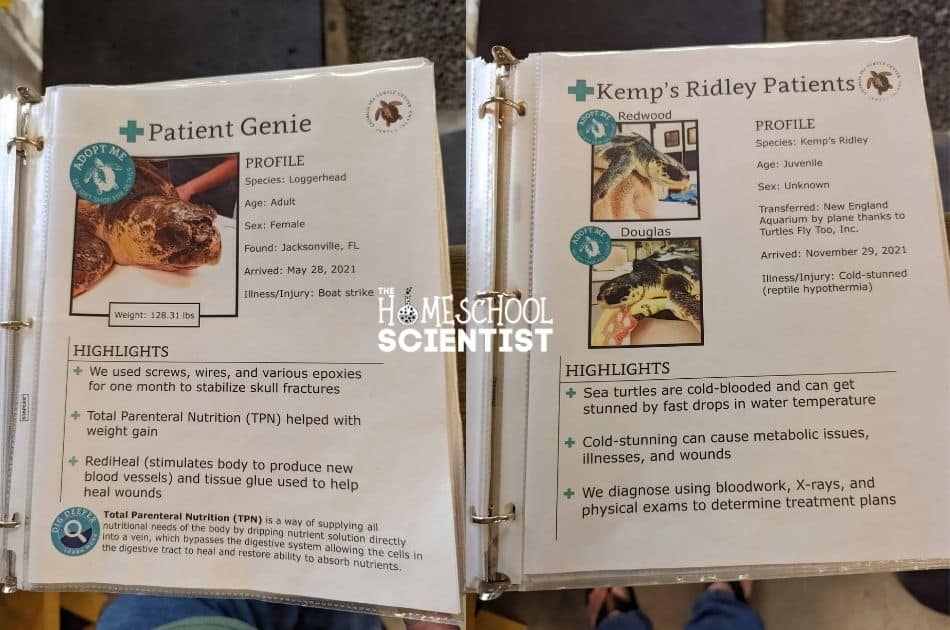
If you would like to know more about sea turtle conservation and potentially get involved, check out these places:
Karen Beasley Sea Turtle Rescue and Rehabilitation Center
Sea Turtle Preservation Society
Goeco.org – They have volunteer opportunities around the world
Oceanspirits.org based in Grenada
Other Resources to Use with a Sea Turtle Study:
Add art to a sea turtle study with this project.
MANY sea turtle unit study resources.
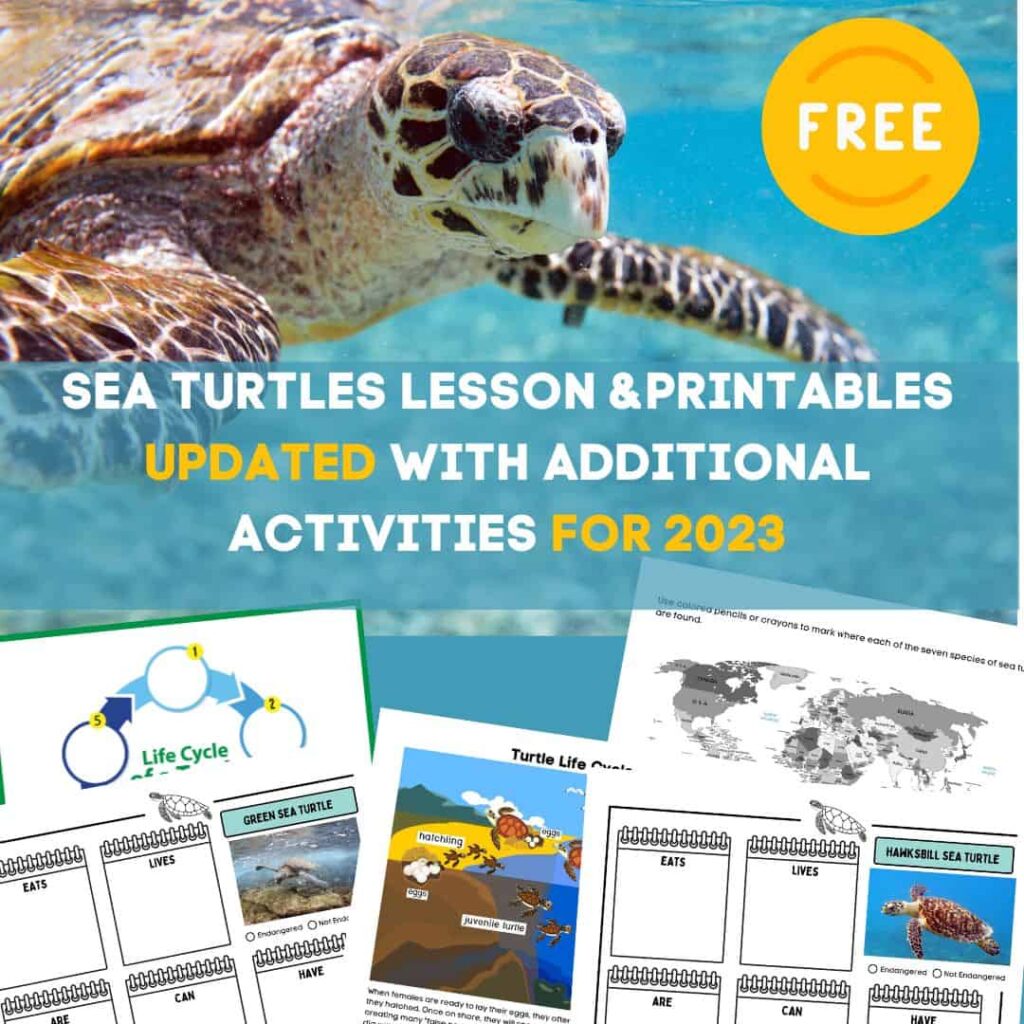
Download the Sea Turtle Activities Printable Pack
Input your email address below, and we’ll send you the activities. Your student can use our list of 35 fun facts about sea turtles while completing the activities.
Read 35 fun facts about sea turtles by clicking here.
I hold a master’s degree in child development and early education and am working on a post-baccalaureate in biology. I spent 15 years working for a biotechnology company developing IT systems in DNA testing laboratories across the US. I taught K4 in a private school, homeschooled my children, and have taught on the mission field in southern Asia. For 4 years, I served on our state’s FIRST Lego League tournament Board and served as the Judging Director. I own thehomeschoolscientist and also write a regular science column for Homeschooling Today Magazine. You’ll also find my writings on the CTCMath blog. Through this site, I have authored over 50 math and science resources.



